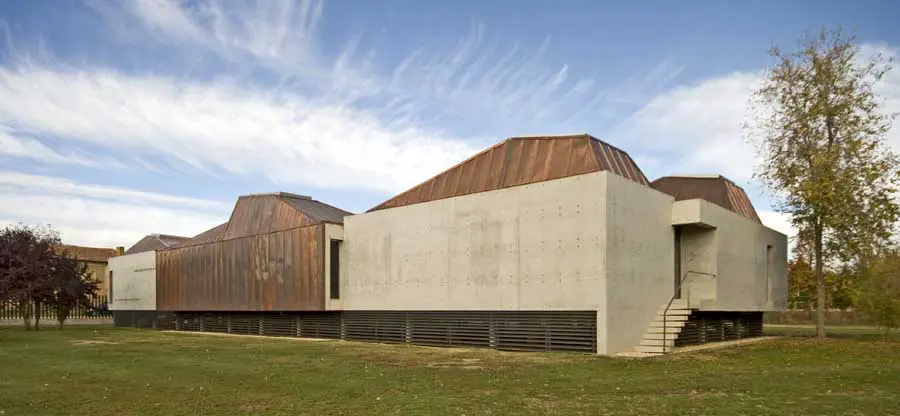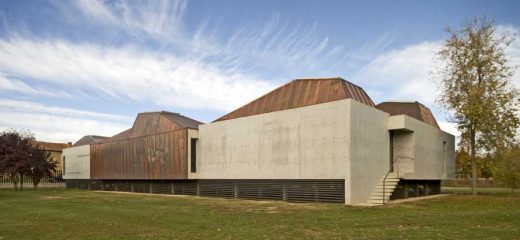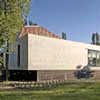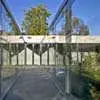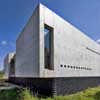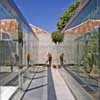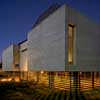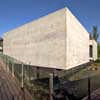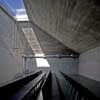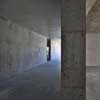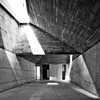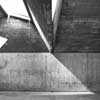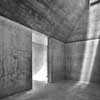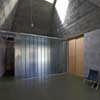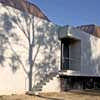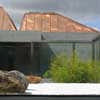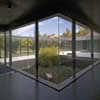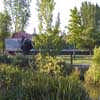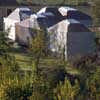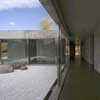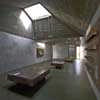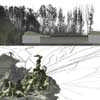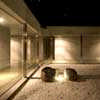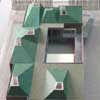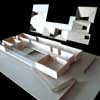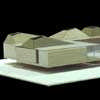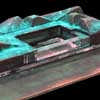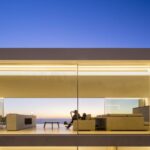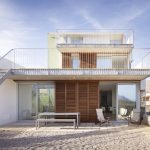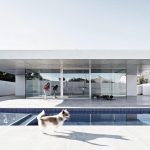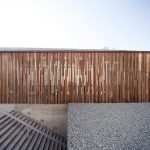Centre for the Interpretation of Rivers, Benavente Building, Architect, Design Images
Centre for the Interpretation of Rivers
Valle del Órbigo, Benavente, Zamora, Spain design by José Juan Barba Arquitectos
Date built: 2008
Design: José Juan Barba Arquitectos
Location: Valle del Órbigo, Benavente, Zamora
1 Sep 2008
Centre for the Interpretation of Rivers Spain
The Vertical Component
CENTRE FOR THE INTERPRETATION OF RIVERS, Interreg. Órbigo, Tera, Esla, Spain
JOSÉ JUAN BARBA
Dr. ARQUITECTO
CANARIAS 5 – 1º C. 28045 – MADRID. SPAIN. T. 34 915396976 F. 912225056 email.- [email protected]
Photographs: Ignacio Bisbal Grandal
The project is carried out on three levels: in relation to the place, responding to the program and developing the perception of the space. The levels mix and converse and the project emerges from where they cross.
1. In its relationship with the place where it is introduced, the design is outlined following premises such as minimal impact on the surrounding nature and therefore intervening in a semi-natural environment with criteria of passive sustainability (the attitude which we believe is the most efficient and active with regard to the surroundings), with a cultural program and using materials whose ageing process allows the building to converse with the changes in tone, colour and light of the surroundings.
All this is done without renouncing the carrying out of an abstract work (not imitative of the context) involving a man-made intervention, a violent work in the sense that Ignasi de Sola Morales expressed, “…architecture is an act of violence, because it changes the nature of the materials it uses and the place where it is situated”, it transforms them, it models them and therefore is violent towards the space on creating something new which did not exist previously. A violence understood as the change which occurs in living beings when they grow, walk and live.
2. Programmatically the project is outlined as the grouping of five modules around a courtyard on two levels. The whole, presented as a single architectural element, develops its five thematic areas as a single room, its routes embracing the two courtyards, which represent two opposites, artificiality and nature, as counterpoints on which life the creation of life is based.
Life is represented and interpreted here by the river, the element which waters the terrain in accordance with its natural-geographical conditions but also as a creating process of life through the artificiality imposed by man.
Its condition of a flood plain, situated in a fluvial valley defines the solution proposed from its beginnings. Therefore the building is elevated above the natural terrain by means of a system of piers. Access is gained by means of a ramp, which serves for penetration but also as an element which, on being elevated from the terrain, permits its observation, emulating the feeling of being removed for the land which any river gives us when we try to cross it or navigate it.
3. Robin Evans in a text for the Architectural Association in 1997 commented that when a congenitally blind person sees for the first time, the succession of spaces is no longer a horizontal continuity, in the sense of an extension of a succession of events, according to the horizontal sense of movement.
When this person first saw, he was dismayed when he realised that space continued above, dizzyingly beyond his reach. In the project the creation of places is based on a complete understanding of space and the influence of its different escapes. The vertical component of this interior space is reflected in the domes and its escapes through the skylights. When we are in the exterior, the evidence of the vertical component is intensified by contrast; there is no roof and the sides are almost incorporeal.
The material in itself does not limit the lateral views. However when there are two walls, their plays of reflection and reflections limit the lateral views. A new landscape or the extension of the surrounding landscape is contemplated in the interior of the project.
The crosses create intersections and these are read by the visitor by means of routes. All the routes are around the two courtyards which represent artificiality through the Japanese garden which is elevated at the level of the pavement of the rest of the Centre. It reminds the visitor of its artificial existence as it is separated from the land, and nature with the presence of a second riverbank garden which grows in direct contact with the land.
The tour of the Centre begins with a projection room where the visitor receives his first immersion in information. The tour is always double or infinite, as there are no doors between the different spaces, and allows both the visitor and the organizer of the Centre to establish infinite routes depending on exhibition needs or the interests of the visitor.
The building is wrapped up in itself to create an abstract idea of the surroundings. The whole project endeavours to make the most symbolic points of the program clear constantly.
The exit after the tour is along a roofless corridor with glass walls. This is the only time one loses the direct views of the courtyards although their presence is still felt. The two glass walls and the absence of a roof attempt to give the visitor the feeling of going along inside a river. The exit, like the arrival, is along a walkway over a garden with native plants.
José Juan Barba
Dr Architect
TECHNICAL CREDITS
CENTRE FOR THE INTERPRETATION OF RIVERS
Project: Dec 2004
Furnishing and models project: Jul 2005
Construction: Sep 2005 – Aug 2007
Furnishing: Feb 2008
Budget: 1,225,000 euros
Total built area: 900 m2
Garden area: 220 m2 (Total: 1,120 m2)
Architect: José Juan Barba (project and management of the works)
Collaborating Architect.- Concha Llorden (project). Collaborators.- Andrés Ferrero, Alex Puigborn, Pablo Cruz (infography), Juan Carlos Yusto (model), Menelaos Yorgos, Ramón Barreiro (structures), Miguel A.Vecino (quantity surveyor), Daniel Juan (quantity surveyor) Rosa Pérez Fdez. (engineer)
External Collaborators: J.M. Aller (interior models), Illione (furnishing), Alberto de Prado, Hess-Iluminación (lighting), Agustín Maestro Garnilla (installation of air conditioning), Ferroblan S.L. (concrete), Luis Aragoneses (PERI).
Construction Company.- Villar y Vara, Ferroblan (structure of vertical concrete and ramp), Manuel Rubial S.L. (stainless steel), Terraconti (floors), Asprosub (garden).
Developer: Interreg Projects, European Union. Spain/Portugal
Photography: Ignacio Bisbal Grandal
FICHA TÉCNICA
CENTRO DE INTERPRETACIÓN DE LOS RÍOS
Proyecto: Diciembre 2004
Proyecto de amueblamiento y maquetas: Julio 2005
Construcción: Septiembre 2005 – Agosto 2007
Amueblamiento: Febrero 2008
Presupuesto: 1,225,000 euros
Superficie edificada: 900 m2
Superficie de la urbanización: 220 m2 (Total: 1.120 m2)
Arquitecto: José Juan Barba (Proyecto y Dirección de Obra)
Arquitecto Colaborador.- Concha Llorden (Proyecto). Colaboradores.- Andrés Ferrero, Alex Puigborn, Pablo Cruz (infografías), Juan Carlos Yusto (maqueta), Menelaos Yorgos, Ramón Barreiro (estructuras), Miguel A.Vecino (aparejador), Daniel Juan (aparejador) Rosa Pérez Fdez. (Ing.)
Colaboradores externos: J.M. Aller (Maquetas contenidos), Illione (Amueblamiento), Alberto de Prado, Hess-Iluminación (Iluminación), Agustín Maestro Garnilla (Instalación aire), Ferroblan S.L. (Hormigones), Luis Aragoneses (PERI).
Constructora.- Villar y Vara, Ferroblan (estructura de hormigón vertical y rampa), Manuel Rubial S.L. (Acero Inoxidable), Terraconti (Suelos continuos), Asprosub (Ajardinamiento).
Promotor: Proyectos Interreg. Unión Europea. España/Portugal
Fotografía: Ignacio Bisbal Grandal
LA COMPONENTE VERTICAL.
CENTRO DE INTERPRETACIÓN DE LOS RÍOS, Interreg. Órbigo, Tera, Esla, España.
El proyecto se desarrolla a tres niveles: en relación con el lugar, respondiendo al programa y desarrollando la percepción del espacio. Los niveles se mezclan, dialogan y de sus cruces va surgiendo el proyecto.
I. En su relación con el lugar en el que se implanta, el desarrollo se plantea desde premisas como el menor impacto posible en el entorno natural y por tanto intervenir en un medio semi-natural desde criterios de sostenibilidad pasiva (la actitud que creemos más eficiente y activa con su entorno), con un programa cultural y aplicando materiales cuyo envejecimiento le permita dialogar con los cambios tonales, cromáticos y de luz del entorno, todo ello sin renunciar a la realización de una obra abstracta (no mimética con el contexto) en lo que supone una acción realizada por el hombre, una obra violenta en el sentido que expresaba Ignasi de Sola Morales, “…la arquitectura es un acto de violencia, porque cambia la naturaleza de los materiales que usa y el lugar en el que se asienta”, los transforma, los modela y con ello violenta el espacio al generar algo nuevo que previamente no existía. Una violencia entendida como el cambio que se produce en los seres vivos cuando crecen, transitan y viven.
2. Programaticamente el proyecto se plantea como la agrupación de cinco módulos en torno a un patio en dos niveles. El conjunto, presentado como un único elemento arquitectónico, desarrolla sus cinco áreas temáticas como una única sala, abrazando sus recorridos estos dos patios que representan dos opuestos, artificialidad y naturaleza, como contrapuestos a partir de los cuales se genera la vida.
La vida es aquí representada e interpretada por el río, el elemento que riega el territorio en función de las condiciones natural-geográficas del mismo pero también como processo generador de vida a través de la artificialidad impuesta por la mano del hombre.
La condición de territorio inundable, situado en un valle fluvial, define la solución planteada desde su inicio. Así, la propuesta queda elevada del terreno natural mediante un sistema de pilotis, realizándose el acceso a través de una rampa que sirve de penetración pero también de elemento que, al elevarse del territorio, permite su observación, emulando la sensación de desprendimiento de la tierra que cualquier río nos brinda cuando intentamos cruzarlo o navegarlo.
3. Robin Evans en un texto de 1997 para la Architectural Association, comentaba como cuando un ciego congénito recupera la visión la sucesión de espacios deja de ser una continuidad horizontal, en el sentido de extensión de sucesión de acontecimientos, según el sentido horizontal del desplazamiento. Cuando esta persona fue capaz de ver, quedó consternado al darse cuenta de que el espacio continuaba hacia arriba, vertiginosamente, mucho más allá de su alcance.
En el proyecto la generación de lugares parte de una comprensión completa del espacio y de la incidencia que sus differentes fugas nos presenta. La componente vertical del espacio interior queda reflejada en las cúpulas y su fuga a través de los lucernarios. Cuando nos encontramos en el exterior la evidencia de la componente vertical del espacio se intensifica por contraposición, no hay cubierta y sí laterales casi incorpóreos.
El material en sí, no limita las visiones laterales, sin embargo cuando disponemos dos muros, sus juegos de reflexión y reflejos limitan las visiones laterales, se plantea un paisaje nuevo o la ampliación del paisaje circundante en el interior del proyecto.
Los cruces generan intersecciones y estas son leídas por el visitante mediante recorridos. Todos los recorridos son en torno a los patios que reflejan artificialidad a través de un jardín japonés sobre-elevado al nivel del pavimento del resto del Centro, recordando su condición artificial al separarse del terreno y su condición natural al arropar un segundo jardín, un jardín de ribera que crece directamente en contacto con el terreno.
El recorrido del Centro se inicia con una sala de proyecciones donde el visitante recibe un primer baño de información. El recorrido siempre doble o infinito, al no existir puertas entre los differentes espacios, permite que tanto el visitante como el programador del Centro pueda establecer infinitos recorridos según las necesidades expositivas o intereses del observador.
El edificio se envuelve en sí mismo para generar una abstracción del entorno. Todo el proyecto intenta hacer patente de manera constante los puntos más simbólicos del programa.
La salida del recorrido se realiza a través del pasillo descubierto, artificio entre vidrios, único momento en que se pierde la visión directa de los patios aunque su presencia siga presente. La doble pared de vidrios y la ausencia de techo intentan dejar en el visitante la sensación de un recorrido interior a través del río. Su salida, al igual que su llegada vuelve a producirse a través de una pasarela sobre un pequeño jardín de plantas autóctonas.
José Juan Barba, Dr. Arquitecto
Centre for the Interpretation of Rivers photos / information from José Juan Barba Arquitectos 010908
Location: Benavente, Zamora, Spain
Architecture in Spain
Spanish Architecture Designs – chronological list
Spanish Architecture – Selection
Foster + Partners
Nou Camp Stadium
ATARIA – Centro de Interpretación de la Naturaleza de Salburúa
QVE arquitectos
ATARIA Vitoria
Centre New Entrepreneurs Albacete, Salburúa, Vitoria
QVE arquitectos
Centre New Entrepreneurs Albacete
Town Hall Renovation by José Juan Barba Arquitectos
Architecture Design
Contemporary Building Designs – recent architectural selection from e-architect below:
Architecture Walking Tours by e-architect
Comments / photos for the Centre for the Interpretation of Rivers Architecture page welcome

